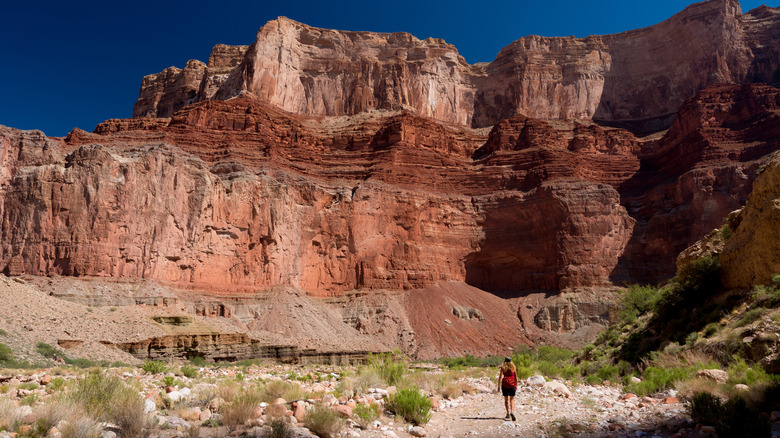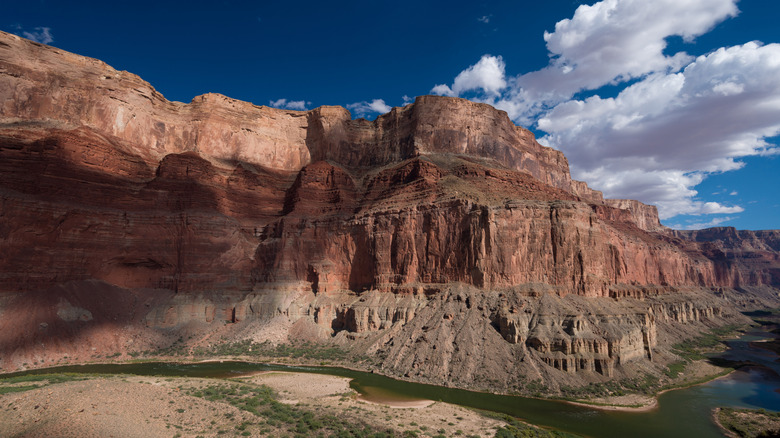The Grand Canyon's Most Dangerous Hike Is Also Its Most Breathtaking With Steep Drops And Brutal Heat
From peaceful solitude on backcountry backpacking routes to unforgettable and affordable private helicopter tours, there are plenty of ways to explore the Grand Canyon. One route, however, stands out from the others — but not necessarily for the right reasons. The Nankoweap Trail is known as the single hardest and most dangerous way to see the Grand Canyon. This route goes through the wilderness providing staggering and unmatched views of the surrounding canyons, cliffs, and rugged rocky terrain. However, this 22-mile roundtrip journey can be deadly. The route is extremely narrow in places, and hikers will have to traverse areas with loose rocks beneath their feet and a dizzying drop on one side. The sun might be even more dangerous than the drop. Temperatures on this hike can be over 100 degrees Fahrenheit. It's for this reason that Nankoweap is on the list of trails only the most experienced and skilled hikers should attempt.
The trailhead is less than 5 miles from the North Rim Entrance Station, where, unless you have an America the Beautiful National Park Pass (and here's how to know if you should get one), you can expect to pay $35 per car or $20 per person, if you happen to be walking in. Those planning to hike the Nankoweap Trail will also need a backcountry permit. Most people take around two days to hike down into the canyon and two days to hike back out. There are no water sources available along the route, so trekkers will need to carry all four days worth of water with them.
What it's like to hike the Grand Canyon's most dangerous trail
Hikers on the Nankoweap Trail have to contend with thin paths, with tall sheer cliffs on one side and incredible drops on the other. The sheer drops off the side of this trail are often between 100 and 400 feet down, more than enough to be deadly. The hot sun beating down above and the lack of space to stop and catch your breath make this journey a grueling experience. The views from these narrow red cliff ledges are spectacular and provide an opportunity to see parts of one of the most iconic natural features in the world that few others get the chance to see — if you are able to look down at them without getting nauseous.
Going down might seem easier than going up, but these trails are steep and, in places, are covered with loose rocks. Paired with serious winds, the way down is no less harrowing. Along the way, there may be some other hikers traversing the trail, but for most of the journey, hikers attempting Nankoweap will probably be alone or only with the people they brought with them.
Is it possible to hike the Nankoweap Trail safely?
There's no way around it: the Nankoweap Trail is extremely dangerous. There are a few things potential hikers can do to make it safer, though. For one thing, despite the allure of being alone in the Grand Canyon, the National Park Service does not advise attempting this hike alone, even if you have done difficult hikes in the past. It's also definitely not a good idea to try to travel this route anytime in the summer as the temperatures in the canyon can soar to dangerous levels very quickly.
Hiking in the Grand Canyon is unique, and often significantly harder than hikers expect. The rough terrain means that even seemingly short routes distance-wise take much longer than they might on flatter land. Plus, the high temperatures and water scarcity only add to the difficulty. For these reasons, most who hike the Grand Canyon hike the rim. Very, very few hikers actually hike down into the canyon itself, and when they do, they often choose the slightly easier Bright Angel Trail. Before attempting Nankoweap Trail, it's a good idea to spend a significant amount of time getting comfortable on other hikes inside the Grand Canyon as a way to prepare.


